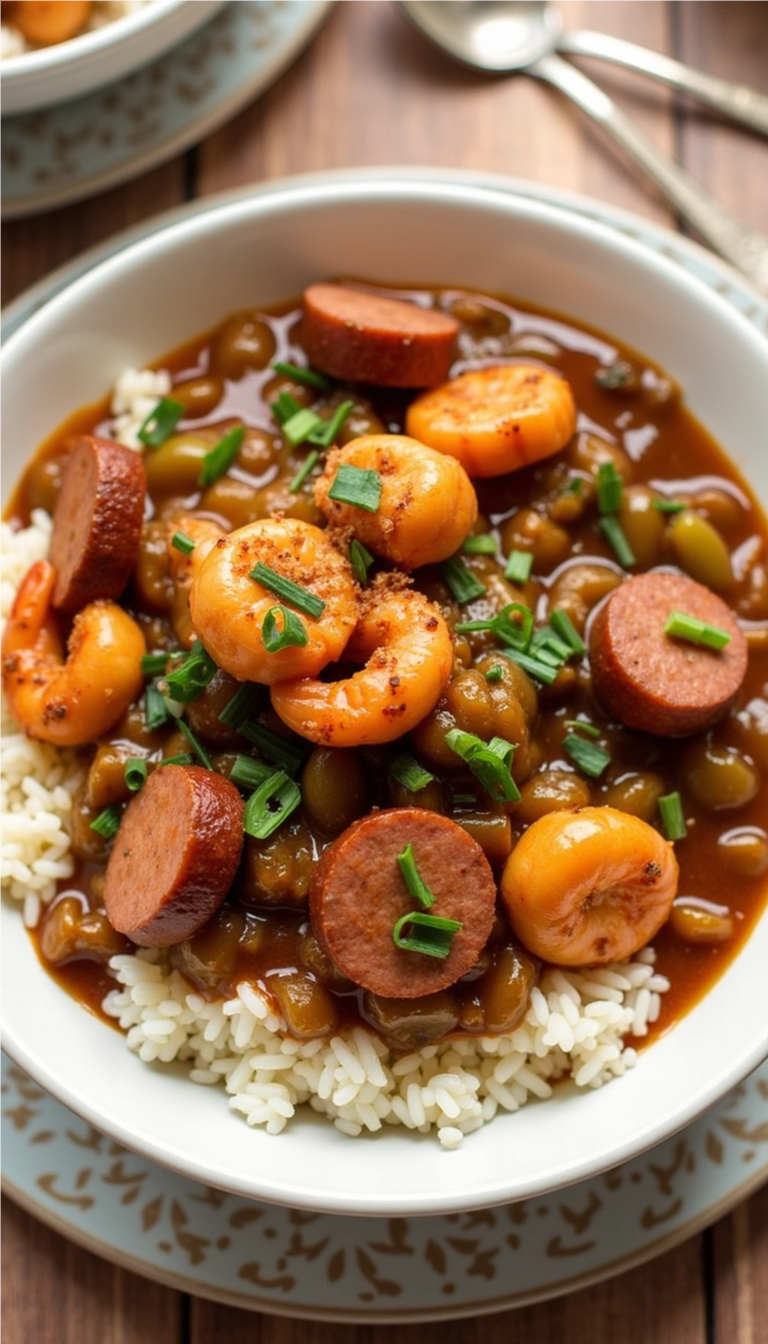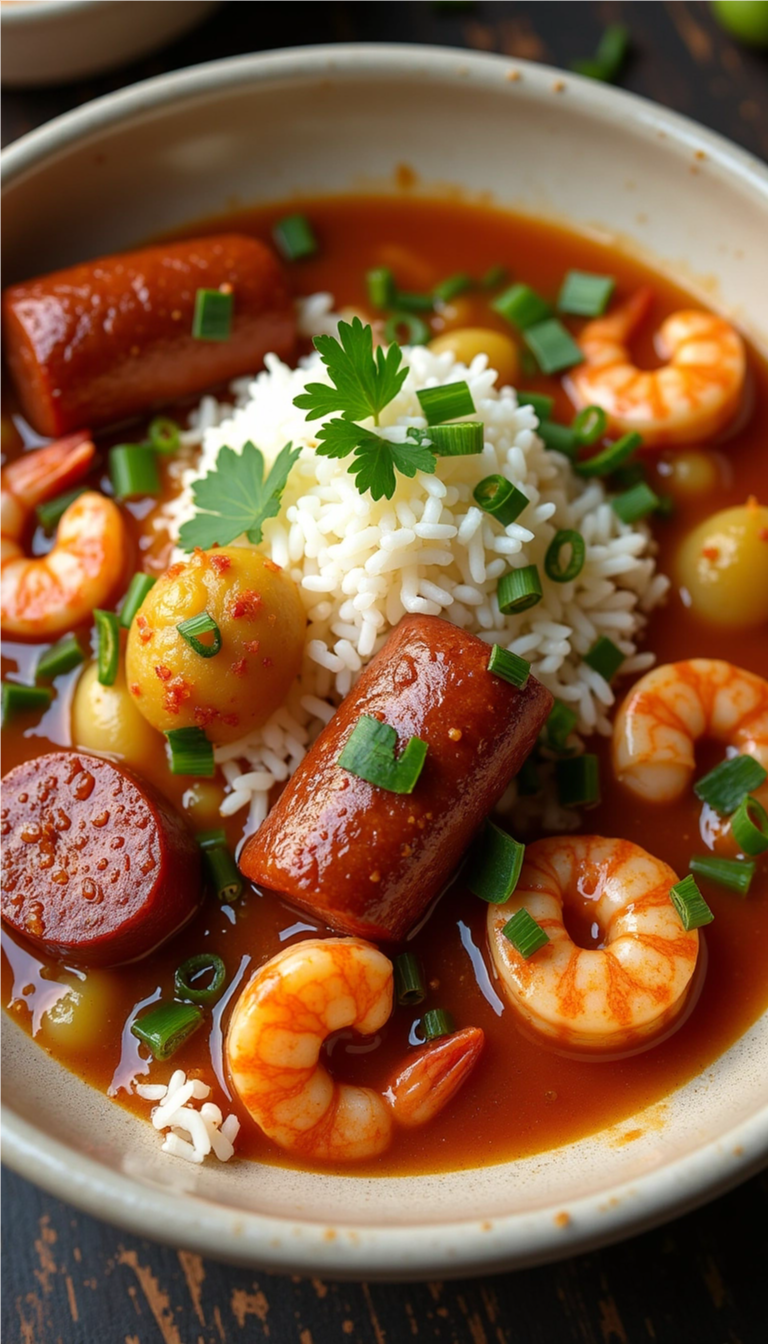Table of Contents
Introduction
Welcome, food enthusiasts! Today, we’re diving into the heart of Louisiana to explore a dish that is as rich in history as it is in flavor: Cajun Gumbo. This hearty stew is a beloved classic, steeped in tradition and packed with bold, robust flavors that warm both the body and soul. Imagine stepping into a bustling kitchen where the air is thick with the tantalizing scents of spices and the melodious bubbling of a delicious concoction on the stove. That’s exactly what you’re about to experience with this homemade Cajun Gumbo recipe.
In the culturally vibrant region of Louisiana, gumbo is more than just food; it’s a way of life. Traditionally served at family gatherings, holidays, and community parties, this dish brings people together, offering comfort and a sense of home. Each spoonful is a story — smoky, spicy, and savory, all intertwined with the rustic charm of Cajun cooking. Whether you’re enjoying it for lunch, dinner, or a special celebration, Cajun Gumbo is sure to leave you and your guests asking for seconds.
But what makes this dish truly special? It’s authentic but with a twist. No more scrambling for rare ingredients or intricate kitchen gadgets — with a few pantry staples and a little love, you can create a pot of gumbo that’s soul-satisfying and incredibly delicious. So, dust off your apron and get ready to bring a taste of Louisiana into your kitchen with this Cajun Gumbo recipe. Let’s embark on this flavorful journey together!
Budget Information
Creating a delightful pot of Cajun Gumbo doesn’t have to break the bank. In fact, this recipe is wonderfully budget-friendly, making it perfect for feeding a crowd or having delicious leftovers. Here’s a breakdown of what you can expect to spend:
- Chicken Breasts or Thighs (2 pieces): Approximately $4.00
- Andouille Sausage (1 pound): Around $7.00
- Shrimp (optional, 1 pound): About $10.00, or replace with crab meat if you prefer
- Onion (1 chopped): Roughly $0.50
- Bell Pepper (1 chopped): Approximately $1.00
- Celery (2 stalks): About $0.75
- Garlic (4 cloves): Around $0.30
- Okra (1 cup, optional): Roughly $2.00
- Paprika (1 tablespoon): Approximately $0.50
- Thyme (1 teaspoon): About $0.10
- Oregano (1 teaspoon): Roughly $0.10
- Bay Leaves (2 leaves): Approximately $0.10
- Chicken or Seafood Broth (4 cups): About $3.00
- File Powder (1 tablespoon, optional): Roughly $1.00
- Flour (¼ cup): Approximately $0.10
- Vegetable Oil or Butter (¼ cup): Around $0.50
Approximate Total Cost: $30.00
Given these costs, Cajun Gumbo is a splendid choice for a large family meal or a gathering of friends. It’s packed with flavors and made from ingredients that might already be cozying up in your pantry.
Why This Recipe Works
The allure of Cajun Gumbo lies in its perfect blend of simplicity and complexity. On the one hand, it’s a straightforward recipe that doesn’t call for advanced culinary skills. On the other, each step and ingredient is thoughtfully chosen to build layers of rich, bold flavors. This dish truly shines because:
- Ease and Flexibility: Its foolproof nature allows room for substitutions and adaptations. You can swap meats or adjust spices to fit dietary preferences without losing its authentic essence.
- Family-Friendliness: Its comforting and hearty nature makes it a meal that will satisfy both kids and adults alike.
- Health Benefits: Packed with protein from meats, vitamins from vegetables, and antioxidants from spices, it’s a nourishing choice that doesn’t skimp on flavor.
Ingredients + Optional Substitutions
Here’s everything you’ll need to recreate this authentic Cajun Gumbo:
- 2 boneless, skinless chicken breasts or thighs, diced
(Substitute with turkey or duck if desired*) - 1 pound of Andouille sausage, sliced
(Smoked sausage can be used as an alternative*) - (Optional) 1 pound shrimp, peeled and deveined
(Or crab meat for a different seafood twist*) - 1 onion, chopped
- 1 bell pepper, chopped
- 2 celery stalks, chopped
- 4 garlic cloves, minced
- (Optional) 1 cup okra, sliced
- 1 tablespoon paprika
- 1 teaspoon thyme
- 1 teaspoon oregano
- 2 bay leaves
- 4 cups chicken or seafood broth
(Low-sodium recommended for flavor balance*) - (Optional) 1 tablespoon file powder
- ¼ cup flour
- ¼ cup vegetable oil or butter
(Choose your preferred fat source*)
Equipment
Equip yourself with these essential tools and utensils to make the cooking process seamless:
- Large pot or Dutch oven
- Whisk
- Cooking spoon
- Cutting board
- Chef’s knife
- Measuring cups and spoons
- Airtight containers (for storage, if needed)
Step-by-Step Recipe Instructions
-
Prepare the Roux: Start this culinary adventure by heating ¼ cup of vegetable oil or butter in a large pot or Dutch oven over medium heat. Slowly add ¼ cup of flour, whisking constantly to create a roux — this vital base should transform into a rich, chocolate-brown hue similar to peanut butter after about 15 minutes. Remember, patience is key. Keep stirring to evoke that signature toasted aroma without any burning.
-
Sauté the Vegetables: Next, introduce the Holy Trinity of Cajun cuisine — chopped onion, bell pepper, and celery — directly into your brown roux. Sauté this aromatic mixture for 5-7 minutes until the veggies are softened and fragrant, giving your kitchen a whiff of NOLA charm. Add minced garlic and let the fragrance flourish for another couple of minutes.
-
Add Proteins and Spices: Now bring the protein party by introducing diced chicken and sliced sausage into the pot. Sauté for another 3-5 minutes, allowing them to embrace the flavorful heritage of the roux. Sprinkle paprika, thyme, oregano, and bay leaves over the mix; your kitchen should now be brimming with an irresistible aroma.
-
Add Broth and Simmer: Pour in 4 cups of chicken or seafood broth, turning up the heat to a gentle boil. Once bubbling, reduce to a simmer and let the magic happen for 30 minutes. This allows the diverse flavors to meld together, resulting in a sauce that’s positively piquant and deeply savory.
-
Add Seafood and Okra (Optional): If you’re going for the seafood version of this hearty stew, now is the time to fold in shrimp or crab, together with okra if using. Simmer for an extra 5-10 minutes until the seafood cooks perfectly. The okra will serve as a natural thickener, adding to that traditional gumbo experience.
-
Season and Adjust: Taste-test your creation and season to perfection with salt, pepper, or extra spice if needed. For extra thickness and quintessential Cajun flavor, stir in 1 tablespoon of file powder just before serving.
-
Serve and Enjoy: Ladle your masterpiece over a bed of fluffy cooked rice, or serve alongside crusty bread. A garnish of chopped parsley or green onions offers a delightful splash of color and freshness.
Prep Time: 20 minutes
Cooking Time: 50 minutes
Total Time: 1 hour and 10 minutes
Nutritional Facts
Here’s a rough estimate of what each serving of Cajun Gumbo offers nutritionally:
- Calories: 350
- Protein: 25g
- Carbohydrates: 12g
- Fat: 20g
- Fiber: 4g
- Sugar: 2g
- Sodium: 800mg
This recipe is naturally gluten-free if file powder is omitted and suits those adhering to a high-protein or wholistic diet. However, always check ingredient labels, especially if using pre-packaged short cuts or dietary-specific products.
Storage and Reheating Tips
One of the best things about gumbo is that it tastes even better the next day! Here’s how you can store and savor it again:
- Fridge Duration: Let your gumbo cool completely before storing. Transfer to an airtight container and refrigerate for up to 3-4 days, allowing the flavors to intensify.
- Freezer Safe: This dish freezes beautifully. Portion out into freezer-safe bags or containers, labeling them with the date. Store in the freezer for up to 3 months.
- Reheating Methods: Thaw frozen gumbo overnight in the fridge. To reheat, warm gently over a stovetop on medium heat until heated through, stirring occasionally. In the microwave, reheat in bursts, mixing in between. Both methods maintain flavor while avoiding a soggy, overheated texture.
- Preserving Texture: Gumbo may thicken in the fridge or freezer. Simply add a splash of broth or water when reheating to restore the original consistency.
Serving Suggestions
Now that your gumbo is ready, here’s how to elevate the dining experience:
- Serve Hot: Always serve gumbo piping hot to appreciate all those luscious flavors melding together.
- Paired with Rice: Gumbo often finds its soulmate in white rice, which balances the rich flavors while making each spoonful utterly satisfying.
- Crusty Bread: As a delectable companion, consider serving with crusty French bread or baguette, ideal for soaking up the broth.
- Garnishing: A final sprinkling of fresh parsley or green onions adds a vibrant note.
- Cultural Variations: Consider serving alongside cornbread or hushpuppies for that full Southern charm.
Reader Tips or Helpful Notes
Here are some tried-and-true tips for perfecting your gumbo experience:
- Shortcuts: Use pre-chopped vegetables to save time on prep.
- Ingredient Upgrades: Add smoked paprika or a dash of cayenne for a subtle, smoky heat.
- Avoid Overcrowding the Pot: Different proteins require different cooking times. Invest time in this step to ensure meats are tender, not overcooked.
- Premium Tools: Utilize a heavy-bottomed cast iron pot to evenly distribute heat while maintaining optimal heat control.
- Storage Hacks: Freeze individual portions for quick weekday meals or use reusable silicone bags for environmental friendliness.
- Flavor Boosts: Stir in Worcestershire sauce for an umami explosion.
- What to Avoid: Don’t rush the roux — it’s the heart of this dish.
- Balance Spice Levels: Cajun cooking doesn’t imply unmanageable heat. Adjust to accommodate your or your guest’s preference.
- Plan to Share: This recipe can easily be doubled to serve larger gatherings.
- Patience is Key: Letting the gumbo rest post-cooking only enhances its flavors, so consider making it a day in advance for your festivities.
Recipe FAQs
Q: What is the difference between Cajun and Creole Gumbo?
A: The primary difference is ingredients. Cajun gumbo is more rustic, typically without tomatoes, and features deep, smoky flavors. Creole gumbo tends to include tomatoes and may utilize a lighter roux, offering a slightly sweeter and refined taste.
Q: Can I make Cajun Gumbo without seafood?
A: Absolutely! The dish remains authentic with just chicken and sausage or with alternative proteins like turkey or duck. The key is maintaining its bold and rich Cajun taste.
Q: How do I thicken my gumbo?
A: A well-prepared roux is fundamental. File powder and okra will further thicken. If still thin, simmer it uncovered or add more file powder sparingly for body.
Q: Can this dish be made vegetarian or vegan?
A: For a veggie twist, substitute meats with mushrooms or add root vegetables like potatoes. Use vegetable broth and replace the roux with a plant-based butter alternative.
Q: How can I control the heat level in my gumbo?
A: Adjust the paprika and consider the addition of cayenne pepper or hot sauce to individual bowls for those craving extra spice, keeping the main pot mild.
Conclusion
There you have it — an exciting recipe that brings the invigorating flavors of Cajun country to your kitchen with ease! Savoring a bowl of spicy Cajun Gumbo isn’t just about the delicious taste, but the heartwarming experience that comes with it. Whether gathered with family, hosting friends, or simply treating yourself, this dish captures the essence of comfort and camaraderie.
So let’s get those hands around a pot and our hearts into this dish. We’d love to hear how your delicious creations turn out, so don’t shy away from sharing in the comments. Upload your masterpiece on social media, tagging us and using #CajunGumboLove to spread the joy. Your feedback and stories bring us immense joy and motivation.
Let’s keep the vibrant tradition of Cajun gumbo alive! Happy cooking and bon appétit.







Comments